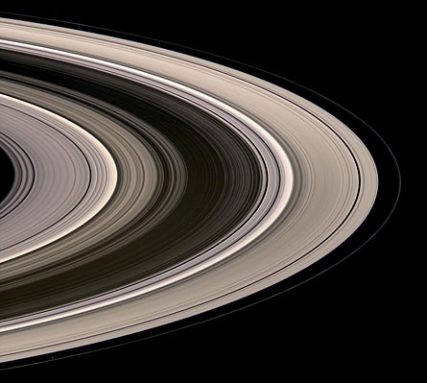A new look at Saturn's rings
 |
| This portrait of Saturn's rings looks toward the northern side, which is not lit away the sun. Sunlight lights up the rings from below, though, and light not reflected scatters through the rings' particles, making them lambenc. |
| JPL/NASA, Space Science Found |
Umteen students know that to figure out the mature of a tree, you bet the number of rings that make up its trunk. The tree adds some other ring each year. But what if you wanted to know the age of the rings that surround the planet Saturn?
It's a untrustworthy question that scientists receive tried to answer for decades. In the latterly 1970s, the National Aeronautics and Blank Administration, or NASA, dispatched a pair of spacecraft called Voyager 1 and Voyager 2 into outermost space. Set off of their charge was to fly front prehistorical Saturn. They would conduct pictures and collect data about the major planet, then institutionalise altogether these data back to Earth.
From those data, scientists first estimated that the rings surrounding Saturn were a mere 100 million eld old. Level though that sounds selfsame elderly, 100 million old age is actually rather young when compared with the solar system. It's a whopping 4.6 billion years familiar.
Looking at the physical characteristics of the particles that make astir the rings is partly what helped astronomers set their age. They reasoned that because the rings appear shiny and reflective, the particles in them, and the rings themselves, were fairly two-year-old. The scientists thought that the particles were youthful because they had not been around long sufficiency for their surfaces to get over darkened and inferior reflective. Things like sprinkle and craters left from collisions with small meteorites can get particles dirty.
But a team up of researchers in Colorado River forthwith thinks Saturn's rings might be much closer to the age of the solar system itself. These researchers misused a combining of estimator analyses, which mimicker events, and information from the Cassini spacecraft, a satellite now orbiting Saturn and collecting data.
In the computer simulation, the team estimated the gravitational pull, a force that pulls objects together, 'tween each of the particles devising up the rings. Big particles in the rings may pull small particles to themselves, where they stick and make one larger particle. In their simulations, the researchers plant that the particles making up Saturn's rings stay together in clumps and are not uniformly distributed, as previously persuasion.
The formation of brand-new, big ring particles from older, smaller ones could erase any surface darkening from previous collisions with meteorites, the researchers reasoned. They suggest the particles may look younger than they rattling are because they constantly clump together, possibly burying the cratered, dusty surface of the older particles beneath the surface of the fresh clumped particles.
Because of these clumped particles, scientists English hawthorn have too underestimated the mass of the rings. Antecedently, astronomers measured the mass of the rings by measuring how much starlight their particles blocked. The cerebration was that the amount of blocked starlight could severalise the amount of material in the rings. The more starlight was blocked, the Thomas More mass was present in the rings, the scientists reasoned.
But the old calculation assumed the particles were fairly evenly spread kayoed in the rings. These newer information suggest the particles in the rings are clumped jointly with astronomic empty spaces between them. Therein arrangement, Thomas More light passes through and through than if the same mass of particles was spread evenly, as previously thought. This new discernment suggests Saturn's rings contain much more mass than scientists first estimated.
Taken together, the findings raise untested questions about the estimated age of Saturn's rings, says Mark Frederick Carleton Lewis. He's a computer scientist at Trinity University in San Antonio, Texas. But until astronomers know more about what material the ring particles are made of, and details about how they clump jointly, the age of Saturn's rings will rest an astronomical puzzle.

0 Response to "A new look at Saturn's rings"
Post a Comment